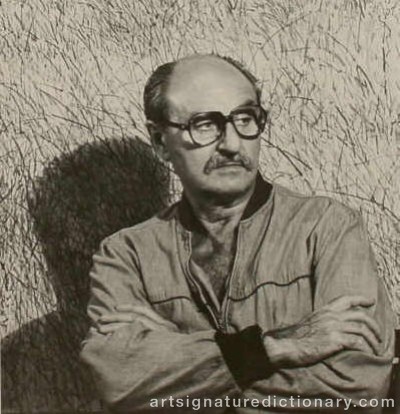
Gabor PETERDI
1915–2001, Hungary/USA
Biography
Discover the life and artistic journey of Gabor PETERDI (born 1915, Hungary, died 2001, USA), including key biographical details that provide essential context for signature authentication and artwork verification. Understanding an artist's background, artistic periods, and career timeline is crucial for distinguishing authentic signatures from forgeries.
Gabor Peterdi was born in Budapest on September 17, 1915, Gabor Peterdi began his studies at the Hungarian Academy. His first solo exhibition was mounted at the Ernst Museum when he was just fifteen years old. In 1930 Peterdi won the Prix de Rome for painting and continued his studies at the Academia delle Belle Arti. The following year he went to Paris to attend the Academie Julian and the Academie Scandinavien. There, the young artist met Szenes and Maria Helena Vieira da Silva, and was thrust into the avant-garde.
Peterdi joined Atelier 17 in Paris in 1933, and through Stanley William Hayter (cat. 60) he became enchanted with the burin and the plate. Gradually developing an intimacy with engraving, he explored every phase of the technique.
In 1939, Peterdi emigrated to the United States. Later that year, his first American one-man exhibition of paintings opened at the Julien Levy Gallery in New York. Seven years later, having served in the army, Peterdi resumed his printmaking career at Atelier 17 in New York. He found working with the copperplate cathartic after his military experiences. His first prints reflected the horrors and destruction of war, but he soon began representing natural awakenings and biblical beginnings in such works as Adam and Eve (Johnson 35). At this time, the artist created his first color intaglio, Sign of the Lobster (Johnson 29), which incorporated eight stenciled colors and an etched and engraved key plate. Here Surrealism resurfaced in a distinctive, personal response to Hayter and Miro.
Maintaining his activity at Atelier 17, Peterdi began teaching at the Brooklyn Museum in 1948, organizing the graphic arts workshop there. His paintings and prints of this period were dominated by his own gestural imagery, the result of exposure to Abstract Expressionism. Peterdi's creative approach to intaglio continued to expand as he invented new techniques and printed from ever larger plates.
In 1952 he became an associate professor of art at Hunter College, where he taught until 1959. In 1953, he also began teaching at the Yale-Norfolk summer school, and he joined the art faculty of Yale University as a visiting professor, gaining a full-time appointment in 1960. Afterwards, Peterdi sustained a close association with Yale through his position as professor emeritus.
Peterdi's book Printmaking Methods Old and New was published in 1959. It remains a standard technical reference for both printmaking students and professionals. Peterdi has also exerted his influence on American printmaking in well over a hundred solo exhibitions. Currently, the artist continues to work and exhibit widely.
Gabor Peterdi died on August 13, 2001 in Norwalk, Connecticut.
Source: http://www.artisfungallery.com
Explore other artists
Discover other notable artists who were contemporaries of Gabor PETERDI. These artists worked during the same period, offering valuable insights into artistic movements, signature styles, and authentication practices. Exploring related artists makes it easier to recognize common characteristics and artistic conventions of their era.